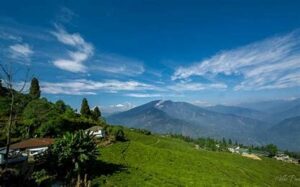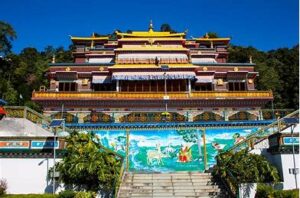At the centre of the state Tripura, lies Ujjayanta Palace. The name Ujjayanta means ‘The Palace of Victory’ in Sanskrit. It is not just a magnificent structure but a fascinating structure of Tripura’s rich history, diverse mythology, and dynamic architecture.
This tall-standing palace is also known as Nuyungma, which holds many secrets of the ancient era. The palace, located in the heart of the city, is a major royal residence named by the Nobel Laureate Rabindranath Tagore. He was a frequent visitor to Tripura.
The palace has magnificent tiled flooring, elegant doors, and curved wooden ceilings that show the architects’ brilliance at the time. The palace has public halls, a throne chamber, a Durbar hall, a library, a reception hall, and a Chinese room.
Ujjayanta Palace is now a state museum well-known for displaying the lifestyle, arts and cultural artifacts, and crafts of Northeast Indian people. The three-story palace has a diverse architectural style and is encircled by serene Mughal gardens. This palace gives a unique experience of the royals living in the Middle Ages.
History
Originally the palace was built in 1862 by King Ishan Chandra Manikya. However, the devastating earthquake of 1897 destroyed the palace. Undeterred, Maharaja Radha Kishore Manikya rebuilt it between 1899-1901; symbolizing the dynasty’s grandeur.
The grandeur that the transformation brought, changed the minds of the royals. Soon, the palace served as the royal residence of the Manikya dynasty for decades. The palace was redecorated and its halls reverberated with the implication of the dynasty’s power, diplomacy, and cultural backing.
In the year 1972, the state of Tripura attained statehood. Since then the palace embraced a new role, housing the State Legislative Assembly until 2011. Today, it proudly carries the legacy of the State Museum and Archives.
Mythology
The name Ujjayanta itself draws inspiration from Hindu mythology. Ujjayanta was the celestial city of Indra, the king of Gods. He symbolizes prosperity and wealth. His aspirations are reflected in the palace’s architecture and dynasty.
The palace was believed to be surrounded by divine connection. The adjacent temples near the palace are dedicated to deities like Lakshmi Narayan, Uma-Maheshwar, Durga, and Jagannath. It hints at the deep-rooted connection between the palace and the spiritual beliefs of that time.
Architectural motifs showcase subtle references to mythical beings and narratives that are portrayed on the palace walls.
Post Independence
Ujjayanta Palace was used as the royal residence until 1947 when the princely state of Tripura merged with the Indian Union. The government bought this palace from the royals in the year 1972. Soon it was converted into a museum to showcase the cultural and historical heritage of Tripura, displaying artifacts, sculptures, and paintings. The palace is still surrounded by well-maintained gardens which enhances its overall aesthetic appeal.
Tripura State Museum
The museum within Ujjayanta Palace houses a rich collection of royal memories. It includes the personal belongings of the royal family, ancient sculptures, archaeological findings, and items reflecting the history and culture of Tripura. The state’s cultural heritage is displayed through its various artifacts, sculptures, paintings, and manuscripts housed within the palace walls. The Tripura Winter Festival, held annually is a display of this palace and its culture.
Architecture
The Ujjayanta Palace is a masterpiece in itself. It is a blend of the grand neo-classical styles with Mughal and Roman influences. The majestic domes, arched doorways, and well-defined carvings narrate a story of cultural exchange.
These two-storied buildings are against three imposing domes, which are as tall as 86 feet. The palace eludes the notion of royalty. The royals lived lavishly. To establish their significance and presence, they would invest the best features and materials into these domes.
The Mughals were known for their trimmed luxurious gardens with pools and fountains. This Mughal-inspired palace also showcases the same picture of elegance.
The interiors were exquisitely built. The frescoes are built of the best resources and excellent craftsmanship. Exquisite chandeliers and frescoes depict the mythological scenes. The ceilings are decorated with ornaments and the floors are made of the finest marble. Each detail showcases the royal way of living.
Construction Techniques
The palace has been standing tall for many years. This can be credited to its ingenious construction techniques which was built in such a way that even earthquakes won’t bring it down. Local red late-rite bricks were used extensively to make the structure durable.
Lime mortar is a special type of mortar that is sourced from oyster shells. These were used to bind the bricks together. This mortar hardens over time, contributing to the structure’s stability.
A hidden wooden framework within the walls provided additional support and flexibility, making the palace resistant to earthquakes.
Hidden Symbols
Intricate Mughal-inspired motifs like jali work (latticed screens) and cusped arches reflect the cultural exchange of that era.
Subtle carvings depicting scenes from Hindu mythology, such as stories of gods and goddesses, can be found on the palace walls. Royal emblems like the Tripura royal family’s coat of arms, featuring a two-headed bird (Garuda) and a conch shell, are displayed in various parts of the palace. These displays are a remembrance of age-old practices and inspiration.
Fascinating Incidents
A grand palace like this is bound to witness greatness. One such display was the royal wedding in 1922. The grand Durbar Hall within the palace hosted the lavish wedding ceremony of Maharaja Bir Bikram Kishore Manikya in 1922.
The palace served as a center for cultural activities. The Durbar hosted many renowned artists, and musicians, and entertained scholars from across the country.
The palace is rumored to have a hidden escape route. Legend has it that a secret underground passage connected the palace to a nearby hillock; which was used by the royal family in times of danger..
Conclusion
Ujjayanta Palace is more than just a monument; it’s a living legacy and an architectural marvel. It has an elaborate history, mythical connections, and architectural finery that puts us in awe at this date. The palace holds the undisclosed life of the Royals and of the history. It’s about the construction techniques, hidden symbols, and fascinating stores that build an appreciation of the craftsmanship of that time in history It offers a glimpse into the soul of Tripura, waiting to be explored and appreciated.
Unravelling a billion untold stories, one chapter at a time, Humans of Northeast takes you on a discovery through vibrant Northeast India – a land rich in people, places, and culture. Ready to immerse yourself in more such stories? Visit our page HONEI to read more about narratives that inspire and uplift.




